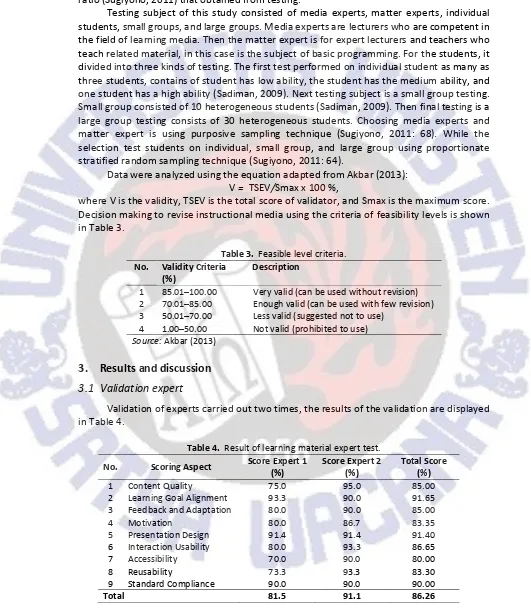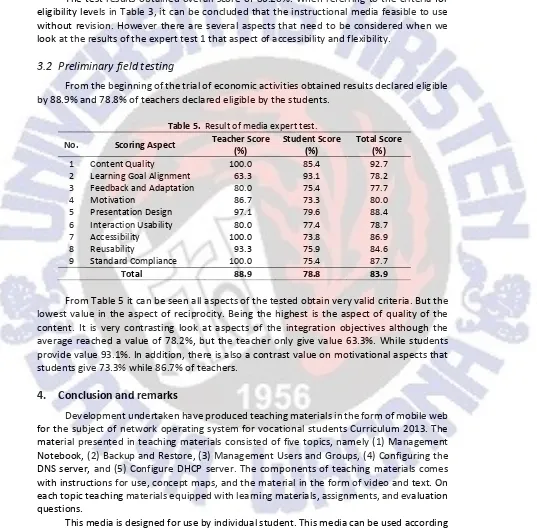Mobile learning materials of networking operating system students
for vocational high school
Muhammad Faiz Firmansyah, Aji Prasetya Wibawa, Heru Wahyu Herwanto
Department of Electrical Engineering, Jl. Semarang No. 5, Malang 65145, Indonesia
Abstract
In an absolutely necessary process of learning a media or instructional materials in the form of modules and tutorials that can be used in the classroom and in the field. Along with the development of information technology and telecommunications (ICT) at this time, then naturally the teaching materials are also experiencing growth. Based on observations in one of the SMK in Malang, 80% of students have gadgets such as mobile phones. The purpose of this study was to develop a web-based interactive learning media that can be accessed through mobile devices. Instructional media successfully developed using the model development Borg & Gall (1979) with the level of validity of experts (86.26%) and the level of validity by users (83.9%).
Keywords interactive media, mobile devices, mobile learning
1.
Introduction
The number of Internet users in Indonesia has increased every year. According to the survey, internet users in Indonesia (85%) access the Internet from a smartphone. The majority of Internet users in Indonesia is the age of 18–25 years. By level of education, the distribution of mobile phone users the highest individual is an individual with higher education, namely D3/S1 (94.36%) and S2/S3 (90.91%). As for respondents with secondary education on the proportion of mobile phone ownership reached (89.67%). It means that do not have a mobile phone in the middle of education only (10:43%).
The development of mobile phone technology is so powerful negative impact on the world of education. In the preliminary observations made in one of the SMK in Malang, some students get test scores below the Minimum Competency Standards. As an example for subjects Network Operating System average student scored 70 of the standard value of 80. This is because students spend more time to do other more interesting activities for example listen to music, play cell phone, play games, and chat. Of the other activities that are more attractive to students, the most frequently done by students are chatting with friends and playing mobile phone.
2.
Materials and methods
2.1 Model development
This research uses the model of the development of R & D by Borg & Gall (1983). The following is a step-step development.
Step 1: Research and data collection
SWUP
difficulty in the subject of DNS server. This is due to lack of tools for practice. The learning process is done by using the media whiteboards and PowerPoint resulting in maximal learning process. On the other side of smartphone users in these schools reached 80%. Android is the biggest user (81%), followed by windows phone users (12.5%) and the rest various types of phones and other smartphones (6.5%). Step 2: Planning
This is the planning stage of the development of the media. There are two steps undertaken (1) planning material, and (2) planning interface. Planning involves determining the subject matter and prepare materials in accordance with the objectives that have been included in the syllabus. Planning interface is done by considering four criteria that must be present on mobile learning, (1) Multiple entry points and learning pathways, (2) Multi-modality, (3) In-situ student improvisation, (4) The sharing and creation of student artifacts on the move.
Step 3: Development of a draft product (develop a preliminary form of product)
Product development is based on the design. The material was developed based on the 2013 SMK curriculum. Interfaces developed using HTML, CSS, and PHP. MySQL is used as a data processor. The finished product will be validated by experts of material and media experts to determine whether it is feasible media are presented to students.
Step 4: The field trials (preliminary field testing)
At this step conducted on 6-13 students and 1 teacher. The collection of information / data by using observation, interviews, and questionnaires, and continued data analysis. Questionnaires were used is LORI V1.5 (Nesbit, 2002). Step 5: Revision of the main product (main product revision)
After testing and data analysis, the product will be revised. This revision is intended to minimize errors in the media.
Step 6: The main field trials (main field testing)
In the main field trials conducted on the subject 30-100, data were collected through interviews, observation, and questionnaires. questionnaire and eligibility criteria described in the step to 4.
Step 7: Revision of product operations (operational product revision)
After testing and data analysis, be revised to improve the media. Revisions were made based on input and suggestions for the main field test results.
Step 8: Test the operational field (field operational testing)
In the operational field trials conducted on the subject 40-200, data were collected through interviews, observation, and questionnaires. Questionnaires and eligibility criteria described in the 4th step.
Step 9: Revision of the final product (final product revision)
Having done some testing and data analysis, the product will be revised. The final revision is based on operational advice in trials conducted by different schools before the test.
Table 1. Table learning objectives.
No Basic Competencies Purpose
1 Understanding the disk management in server
1.1 Knowing the type of hard drive type 1.2 Knowing the type of hard drive
partitions
1.3 Knowing the file on the hard disk format
2 Understand how to perform user and group management on the network operating system
2.1 Able to perform group management 2.2 Able to perform user management
3 Backup and Restore 3.1 Knowing that sense backup and restire
3.2 Able to perform backup and restore 4 Understanding how to configure DNS servers 4.1 Knowing the principles and workings
of DNS server
4.2 DNS server is able to perform the installation
4.3 Able to perform DNS server configuration
5
Understanding how to configure the DHCP server
5.1 Knowing the principles and workings of the DHCP server
5.2 DHCP server is able to perform the installation
5.3 Able to configure the DHCP server
Table 2. Table learning objectives material. No. Basic Competencies Subject Matter
1 Understanding the disk management in server
1.1 The type of hard drive
1.2 The type of hard drive partitions 1.3 The format of the files on the hard
drive 2 Understand how to perform user
and group management on the network operating System
2.1 Management Group 2.2 User management
3 Back and Restore 3.1 Backups 3.2 Restore 4 Understanding how to configure
DNS servers
4.1 Principles and workings of DNS server 4.2 Installation DNS server
4.3 Configuring DNS server 5 Understanding how to configure the
DHCP server
5.1 Principles and workings of the DHCP server
5.2 Installation DHCP server 5.3 Configuring the DHCP server
2.2
Test
SWUP
feasible to be used. The type of data collected is quantitative data and qualitative continuum ratio (Sugiyono, 2011) that obtained from testing.
Testing subject of this study consisted of media experts, matter experts, individual students, small groups, and large groups. Media experts are lecturers who are competent in the field of learning media. Then the matter expert is for expert lecturers and teachers who teach related material, in this case is the subject of basic programming. For the students, it divided into three kinds of testing. The first test performed on individual student as many as three students, contains of student has low ability, the student has the medium ability, and one student has a high ability (Sadiman, 2009). Next testing subject is a small group testing. Small group consisted of 10 heterogeneous students (Sadiman, 2009). Then final testing is a large group testing consists of 30 heterogeneous students. Choosing media experts and matter expert is using purposive sampling technique (Sugiyono, 2011: 68). While the selection test students on individual, small group, and large group using proportionate stratified random sampling technique (Sugiyono, 2011: 64).
Data were analyzed using the equation adapted from Akbar (2013): V = TSEV/Smax x 100 %,
where V is the validity, TSEV is the total score of validator, and Smax is the maximum score. Decision making to revise instructional media using the criteria of feasibility levels is shown in Table 3.
Table 3. Feasible level criteria. No. Validity Criteria
Very valid (can be used without revision) Enough valid (can be used with few revision) Less valid (suggested not to use)
Not valid (prohibited to use) Source: Akbar (2013)
3.
Results and discussion
3.1 Validation expert
Validation of experts carried out two times, the results of the validation are displayed in Table 4.
Table 4. Result of learning material expert test.
From Table 4 it can be seen the highest average is in the aspect of integration with the percentage of 91.65% goal it is very reasonable because the goal has been clearly defined in the curriculum syllabus 2013. While there are aspects of accessibility that percentage is lowest is 80.00% which is due to points about the use of media to persons with disabilities. It's got low ratings because the testing is not conducted directly on the user's disability.
The test results obtained overall score of 86.26%. When referring to the criteria for eligibility levels in Table 3, it can be concluded that the instructional media feasible to use without revision. However there are several aspects that need to be considered when we look at the results of the expert test 1 that aspect of accessibility and flexibility.
3.2 Preliminary field testing
From the beginning of the trial of economic activities obtained results declared eligible by 88.9% and 78.8% of teachers declared eligible by the students.
Table 5. Result of media expert test.
No. Scoring Aspect Teacher Score
(%)
Student Score (%)
Total Score (%)
1 Content Quality 100.0 85.4 92.7
2 Learning Goal Alignment 63.3 93.1 78.2
3 Feedback and Adaptation 80.0 75.4 77.7
4 Motivation 86.7 73.3 80.0
5 Presentation Design 97.1 79.6 88.4
6 Interaction Usability 80.0 77.4 78.7
7 Accessibility 100.0 73.8 86.9
8 Reusability 93.3 75.9 84.6
9 Standard Compliance 100.0 75.4 87.7
Total 88.9 78.8 83.9
From Table 5 it can be seen all aspects of the tested obtain very valid criteria. But the lowest value in the aspect of reciprocity. Being the highest is the aspect of quality of the content. It is very contrasting look at aspects of the integration objectives although the average reached a value of 78.2%, but the teacher only give value 63.3%. While students provide value 93.1%. In addition, there is also a contrast value on motivational aspects that students give 73.3% while 86.7% of teachers.
4.
Conclusion and remarks
Development undertaken have produced teaching materials in the form of mobile web for the subject of network operating system for vocational students Curriculum 2013. The material presented in teaching materials consisted of five topics, namely (1) Management Notebook, (2) Backup and Restore, (3) Management Users and Groups, (4) Configuring the DNS server, and (5) Configure DHCP server. The components of teaching materials comes with instructions for use, concept maps, and the material in the form of video and text. On each topic teaching materials equipped with learning materials, assignments, and evaluation questions.
SWUP
materials that mastered. The developed media has been tested several times. The average value of several trials was 85.08%, so that the teaching material may be considered fit for use.
References
Akbar, S. (2013). Instrumen perangkat pembelajaran. Bandung: PT Remaja Rosdakarya Offset.
Akbar, S., & Sriwiyana, H. (2011). Pengembangan kurikulum dan pembelajaran ilmu Pengetahuan
sosial (IPS). Yogyakarta: Cipta Media.
Borg, W.R., & Gall, M.D. (1979). Education research: An introduction. New York: Longman.
Nesbit, J.C., Belfer, K., Leacock, T. (2007). Learning object review instrument v1.5.
Nesbit, J.C., Belfer, K., & Vargo, J. (2002). A convergent participation model for evaluating of learning
objects. Canadian Journal of Learning and Technology, 28(3), 105–120.
Sadiman, A.S. (2009). Media pendidikan: Pengertian, pengembangan, dan pemanfaatannya. Jakarta:
Rajawali Press.


